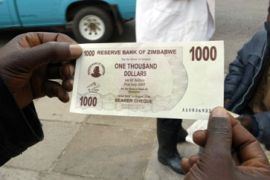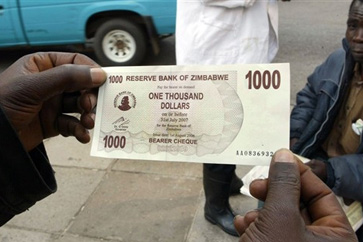Timeline: Zimbabwe’s economic woes
Tracking the economic problems faced by Zimbabwe’s economy in the last ten years.

 |
|
Zimbabwe’s currency is increasingly falling behind |
Zimbabwe’s inflation hit a new record in March 2007, which analysts say is a pointer that President Robert Mugabe’s government is fast losing the battle to turn around a crumbling economy threatening its rule.
This is a timeline of some key events since Zimbabwe’s problems began:
1998: An economic crisis marked by high interest rates and inflation provokes riots and massive support for the Zimbabwean
Congress of Trade Unions headed by Morgan Tsvangirai.
The Movement for Democratic Change (MDC) is formed and Tsvangirai is appointed leader the next year.
Exchange rate: 1 US dollar (USD) = 24 Zimbabwean dollars (ZWD)
1999: World Bank and IMF suspend aid to Zimbabwe over differences with the government on policies.
February 2000: Mugabe’s government loses referendum on constitutional reforms, and in the face of growing opposition to his rule, his supporters invade and seize white-owned commercial farms, saying the land was illegally taken by white settlers.
June 2000: Mugabe’s ruling ZANU-PF party wins parliamentary polls amid charges of fraud and vote-rigging by the opposition.
July 2001: Zimbabwe suffers food shortages that government critics blame on farm seizures, but Mugabe blames on drought. Several Western governments quietly withdraw economic aid over rights abuses by the government and Mugabe’s land policy.
March 2002: Mugabe wins new six-year term in elections. Observers condemn poll as flawed and unfair. The Commonwealth suspends Zimbabwe, while EU imposes travel sanctions and freezes assets of Mugabe’s associates.
Exchange rate: 1 USD = 55 ZWD.
April 2002: A state of emergency is declared as the collapse of commercial agriculture and poor weather contribute to serious food shortages, leaving about half of Zimbabwe’s population in need of emergency food aid. UN agencies, Britain and the US help fund food aid.
November 2003: Hundreds of companies are forced to shut down due to economic hardships and rising inflation.
Exchange rate: 1 USD = 750 ZWD.
February 2004: The EU renews sanctions against Mugabe and his inner circle in February.
July 2004: Exchange rate: 1 USD = 5,624 ZWD.
January 2005: The US labels Zimbabwe as on of the world’s “outposts of tyranny”, a charge rejected by the Mugabe government.
March 2005: Mugabe’s party wins parliamentary election, which the opposition say was rigged. The IMF begins process to expel Zimbabwe from the fund over dues unpaid since 2001.
July 2005: A UN report in July says Zimbabwe should halt its indiscriminate bulldozing of shanty buildings, calling the operation a disastrous venture that had cost 700,000 people their homes or jobs and affected 2.4 million others.
December 2005: Exchange rate: 1 USD = 77,965 ZWD.
August 2006: Zimbabwe’s annual inflation rises above 1,000 percent in April, dramatising the severity of its economic crisis. Redenominated notes are issued in August so that 1,000 old Zimbabwen dollars becomes one new dollar.
Exchange rate: 1 USD = 101 new ZWD = 101,347 old ZWD.
December 2006: At the ZANU-PF congress Mugabe pledges that his government will not collapse. The party approves a plan to move presidential elections back by two years to 2010, effectively extending Mugabe’s rule.
Exchange rate: 1 USD = 162 new ZWD = 162,070 old ZWD.
March 2007: The annual inflation rate, already the highest in the world, races to 1,729.9 per cent in February from 1,593.6 per cent the previous month. On a monthly basis however, inflation slowed to 37.8 percent from January’s 45.4 percent.
Exchange rate: 1 USD = 259 new ZWD = 259,793 old ZWD.